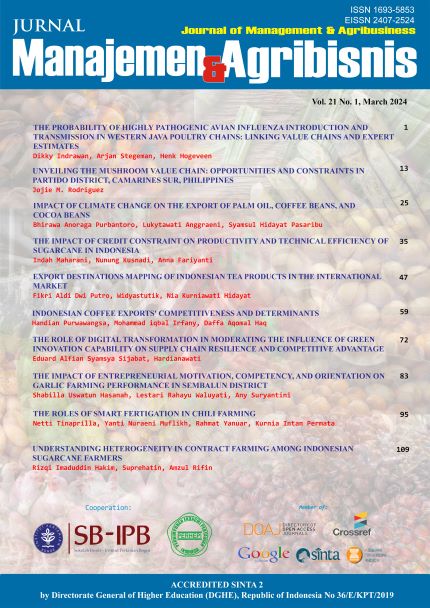Abstract
Smart farming technology has been developed with Agriculture 4.0 to improve productivity and yield quality and solve challenges such as climate change, labor shortage due to regeneration difficulties, and resource efficiency. The objectives of this study were to analyze (1) the characteristics of farmers and chili production using smart fertigation and (2) the cost structure, revenue, profit, and efficiency. The study used primary data from interviews with 83 farmers in Central and East Java. Analytical methods included descriptive statistics, Cobb-Douglas production functions, and R/C. The results showed that smart fertigation farmers, who represented 2% of the total, had higher education (17 years), longer training (124 days), and significant participation in farmer groups (100%). The role of smart fertigation in chili production is to increase productivity (from 8.35 t/ha to 20.67 t/ha), reduce fertilizer use (from 26.730 t/ha to 8.540 t/ha) and reduce labor requirements from 748.17 HOK/ha to 609.33 HOK/ha. Despite the higher farm costs/ha with smart fertigation, the higher total revenue (due to increased productivity and selling price) results in higher profit and efficiency (R/C).
Keywords: smart fertigation, chili farming, adoption decisions, cost savings
Authors
Authors who publish with this journal agree to the following terms:
- Authors retain copyright and grant the journal right of first publication with the work simultaneously licensed under a Creative Commons Attribution License that allows others to share the work with an acknowledgement of the work's authorship and initial publication in this journal.
- Authors are able to enter into separate, additional contractual arrangements for the non-exclusive distribution of the journal's published version of the work (e.g., post it to an institutional repository or publish it in a book), with an acknowledgement of its initial publication in this journal.
- Authors are permitted and encouraged to post their work online (e.g., in institutional repositories or on their website) prior to and during the submission process, as it can lead to productive exchanges, as well as earlier and greater citation of published work (See The Effect of Open Access).

